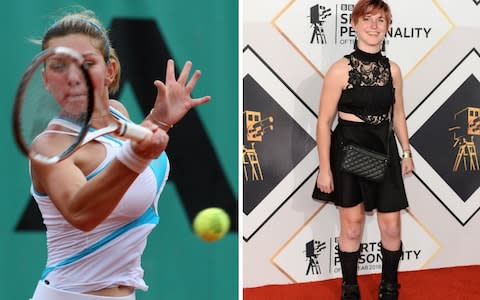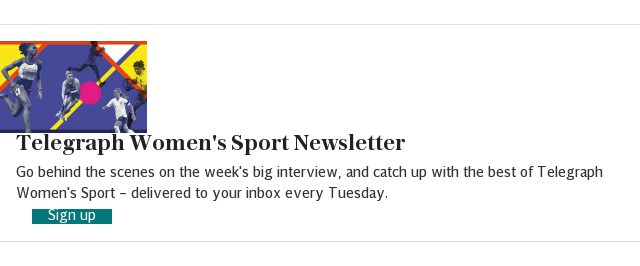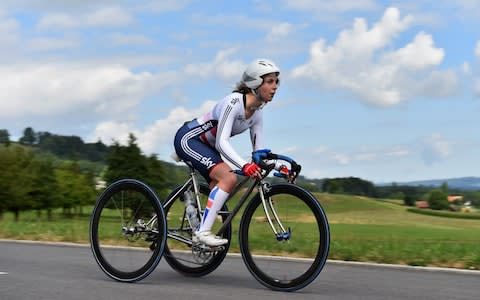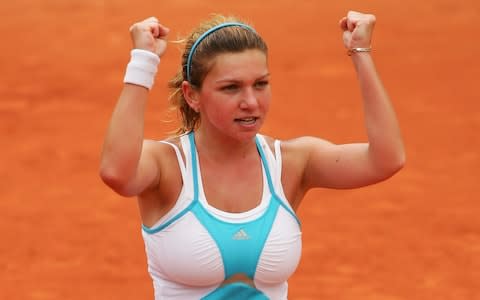The future of sportswomen's bodies


Fishing your sports bra out of your bag, and discussing it in front of 20 other women and a team of scientists and doctors, might seem daunting. But this is part of a quiet revolution taking place in the world of the elite female athlete.
There is a serious reason behind British Olympic and Paralympic sportswomen showing their bras. In a bid to improve performance, they are getting expert advice on how the right fitting sports bra can make all the difference to their sporting results.
Having the latest information and research on how a woman’s body responds to sport and exercise is crucial to any elite athlete. From the menstrual cycle to stress incontinence, the pros and cons of taking the contraceptive pill, and how to broach these taboo subjects with coaches, this new understanding of the different challenges a woman’s body faces is essential to the progress of women’s sport.
When these same athletes go on to compete at next year’s Tokyo Olympics and the 2022 Beijing Winter Olympics, it is highly unlikely that commentators and pundits will be talking about the role that sports scientists have played in maximising performance for Britain’s sportswomen. But the researchers know the ground-breaking difference they have made in beginning to close the gender data gap for women in sport.
One of the unsung heroines is Dr Emma Ross, head of physiology at the English Institute of Sport, providing the latest performance-impacting solutions to athletes across physiotherapy, sports science, medicine and psychology.

Ross’s enthusiasm is infectious as she talks about subjects that might make others squirm. “An athlete’s period is a really good indicator that she is super healthy. She is fuelling correctly, so her body is so healthy that it knows that at any time in pregnancy it can sustain life,” she says. “When an athlete has a healthy menstrual cycle it is a great window on their health.”
The scientist’s ease and passion for educating not just the female athletes but their male coaches – just 10 per cent of elite British coaches are female – comes from a place close to her heart. Ross was a talented rugby player, having played for Cardiff University at Twickenham, before going on to become an accomplished marathon runner and Ironman participant. “Since I had children, my relationship with my body and sport has changed, my physiology has changed. All of that is so fascinating, but not something on which I have felt educated enough – and I am a scientist,” she says.
“Going into Ironman and marathon throws up so many challenges as a female – how do you manage menstruation in a 12-hour race when you have to? Females tend to get left to figure it out.
“Making assumptions isn’t good enough for elite athletes; when your body and mind is your tool to a medal-winning performance you have to get it right.”
It is with this empathy and scientific expertise that Ross approaches running these workshops. For the sake of making sure all involved are comfortable, athletes and coaches attend separate sessions, so they can raise any concerns with their peers.
Areas such as menstruation have often been portrayed as a negative that female athletes must suffer. And, of course, these subjects are largely taboo – under-reported in the media, and rarely spoken about publicly by athletes or coaches. Heather Watson is one of very few high-profile sportswomen to speak openly about periods, while fellow tennis player Simona Halep revealed that she had a breast reduction to improve her sporting performance. Most recently, Team GB Paralympic cyclist Hannah Dines said that she had surgery on her vulva after suffering from painful swelling a result of the impact of her saddle.

The hope is that initiatives such as these EIS SmartHER workshops will enable more research on women in sport. But there are barriers to overcome.
Women working in the field of sports science often describe it as “a blokey world”. One recent study of sports performance research discovered that only 3 per cent of 4,000 participants were female. It is striking that many of those taking the lead in researching a deeper understanding of athlete health are not just female but, like Ross, women who have had experiences of their own in sport.

One elite athlete who dedicated her academic career to better understanding the menstrual cycle is GB cross-country runner Dr Georgie Bruinvels. Having experienced chronic embarrassment around her period as a teenager, and a constant fear that she could be seen bleeding when running, the physiologist used this as inspiration to explore what has been an under-researched area. Bruinvels has developed the FitrWoman app to help women track their periods, and tailor exercise around their menstrual cycles.
Bruinvels was behind a global study of more than 14,000 women into menstrual health and exercise. The study found that 78 per cent found exercise helped ease the symptoms of their period. “I feel this research is a way of telling the world that we need to wake up and realise that menstruation is normal and really healthy,” she says. “We need to accept it as something normal, so we can open up this discussion.”
As well as using her own experiences, Bruinvels was struck by the lack of information available and how that was causing anxiety for female athletes of all abilities. “During my PhD, I came across so many women in sport, a lot of marathon runners of different abilities who wanted to understand their menstrual cycles and why they don’t feel good at all times across the month,” she recalls. “They wanted to find out information about their periods without asking Dr Google that scares people more.”
“I went back to my old school to talk about menstruation and female health in general and I could tell I was talking about a subject people were genuinely uncomfortable talking about. It is such a shame because menstruation affects half the population. We have to take away the sense of it being abnormal,” she says.
Ross is also keen to make sure that the message is spread to the next generation. “Personally, I am so concerned about the gender gap in sports participation and how girls drop out of sport because I have always had sport in my life and it has made such a difference. It is sad to see girls drop out because of their period or what their body is doing,” she says.
“The reason I work in high performance sport is not about the gold medal hanging around someone’s neck, for me it has to be about the bigger picture and inspiring the nation.”
Although much of the research is cutting edge, sometimes obtaining gains in performance can be as simple as wearing the right fitting bra. Ross explains that although all the data from the workshops is yet to be collated, she estimates 80 per cent of the attendees feel their sports bra is negatively affecting their training and performance. This can encompass everything from breathing to movement.

Ross says: “The kind of stresses that are put on your breasts when you are doing high impact work can have a big impact in performance. For athletes to understand that is really important and having poor breast support can affect not just pain or bouncing but sports movement, your mechanics, the energy you are expending, and make you more prone to injury.”
Female inventors are also using their own experiences to create innovations to help women in sport. English-born Amy Jaffers, now based in Queensland, went through embarrassment as a teenager when she noticed her breasts bouncing while playing netball. This led to her developing the Breast Band, a product that can be worn over a bra or sports bra.
“My invention came as a result of my own personal struggles of trying to be active with bigger boobs and not finding anything that was comfortable,” she says. “I found it hard even with sports bras to stop that upwards bounce because sports bras support you a lot more underneath and around.”
“The idea came from surgical compression bands used after breast augmentation surgery. They play a similar role of adding that extra compression across the top, but they are not generally stylish or wearable for ongoing use. My idea was to expand on that but not just for use after surgery, but for everyday sporting demands.”
Ross believes these developments are just the beginning and the workshops conclude with a segment on the bright and bold future of research.
“We wrap up with what the future could look like for athletes, although we don’t have loads of research in this area. The research that does exist suggests that these powerful hormones do fluctuate across the month,” she says. “Not only do they cause us symptoms but they also have a really powerful impacts on how our muscle might build up or break down, how our joints might be less or more stretchy and how that could cause injury.
“Once we get more evidence on all of this wouldn’t it be amazing – as female athletes – if we could tune into your physiology? If I do that training session two days later it might be more potent. If I avoid doing speedy changes of direction on that day and do it two days later or before I might reduce my injury risk?
“There is an opportunity to use your cycle as a pro and not always talking about the cons, that is really exciting. That is our vision for every female athlete to know their cycle and their body.”
